 Image via Pexels Image via Pexels A healthy lifestyle is more than just eating right and exercising. It’s about making decisions throughout the day that lead to a healthier, happier, and more productive life. But for many people, it’s hard to figure out how to save money on their health-related expenses without sacrificing their overall well-being. Here’s the thing: there are many ways to enjoy a healthy lifestyle without going broke! Today, All Ways Well Acupuncture explores some practical options. The Financial Benefits of Enjoying a Healthy Lifestyle It’s no secret that living healthily can lead to big savings in the long run. Eating nutritious foods helps your body function optimally and reduces the risk of diseases like diabetes and heart disease, which come with expensive treatments. Regular exercise improves your energy levels so that you can push yourself further in your career or business pursuits – all while reducing stress, improving sleep quality, and having more to give to your family. These benefits alone are worth investing time and effort into incorporating healthy habits! Starting a Side Business From Your Health Passion If you have a passion for a health-related niche and want to take it further than your daily habits, consider making a business out of it! You could start a blog that shares tips and tricks for leading an active lifestyle, or open a wellness store or fitness studio so that others can benefit from your knowledge firsthand. Engaging your entrepreneurial spirit will not only keep costs down but also provide an additional income source if the venture takes off. Just remember to research the necessary steps before diving in! For example, establishing an LLC (limited liability company) can provide you with the legal protection and structure necessary for success. With an LLC, you have limited personal liability for the debts and obligations of your company. It also gives you a layer of protection for your personal assets should any risks arise within your business operations, among many other perks. Find a formation service that can do most of the work and relieve your stress! Moreover, spreading the word about your business through brochures is a great way to attract more customers. These are a great way to inform others about your health business by providing clear information supplemented with eye-catching photos. If you aren’t sure how to get started, give this a try and take advantage of these free brochure templates! Learning To Meal Prep Meal prepping allows you to save money on groceries while ensuring your meals are nutrient-dense and delicious. Instead of spending extra money dining out or buying premade food from the market, dedicate a few hours over the weekend (or any day) to plan out meals for the week ahead – including snacks! When planning your meals, you know precisely what ingredients are needed for each meal, so nothing goes bad before you use it. Plus, there won’t be any last-minute trips to the store when hunger strikes after work! You should also monitor your caffeine intake. There’s nothing wrong with caffeine in moderation, but you need to be careful about how much you’re incorporating into your diet. A good way to do this is by looking into its different forms – for instance, the difference between an americano and a cappuccino. Working Out at Home If you’ve ever had a gym membership, no one needs to tell you how quickly it can become expensive! Fortunately, there are many at-home workouts available to save you money and make your life more convenient, such as:
The possibilities are endless options for staying fit without breaking the bank. Besides, working at home offers more flexibility because there are no set class times, meaning you can work out when it’s convenient for your schedule. That said, if you want the social benefits of exercising in a group, find a local class that meets at a time you can stick with. Rhythm Pilates has several upcoming workshops that could be a perfect match! Conclusion If you use the right strategies, living a healthy life doesn’t have to drain your bank account. Whether it’s starting a side hustle, sprucing up your resume, learning to prepare meals, or exercising at home, you can enjoy an active life while saving money in the process. Consider the tips above to start building your healthy-yet-affordable habits today! If you’re interested in exploring Chinese medicine and acupuncture, All Ways Well Acupuncture is here to help. Click here to book an appointment! 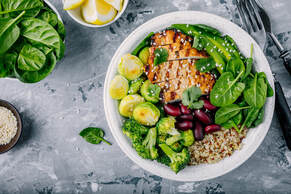 Spring is a time of renewal, regeneration, growth and energy. Plants and animals awaken from their slumber during the cold winter months, and vital nutrients stored in the roots of the plants and bodies of the animals come to the surface as life becomes more vibrant and fluid. Human beings are no different. Humans stay indoors more during the winter months, and tend to pack on a little extra weight in the process. As the weather warms, humans become more gregarious and spend more time outside enjoying nature. This is just a natural process. Therefore, it makes sense that what was observed by the ancient Chinese should still hold true today. Humans are supposed to take their cues from nature. As a species, humans should be more active during the warmer spring months. And to do this, we need proper nourishment. Qi (pronounced “chee”) is sometimes translated into energy. This Qi is the vital substance that keeps our bodies functioning until the day we die. To keep the Qi plentiful, we need to eat the proper foods at the proper times. During the spring, we should be eating foods that have upward energies, such as green, sprouting vegetables. But we also need foods that will provide the extra nourishment for the increased amounts of activity that accompany the season of spring. This is where sweeter foods play a vital role. Foods such as fruits, nuts, yams, carrots and potatoes can provide the extra energy needed during the spring. But be careful not to overdo it. Too much sweet can overload the body and make it sluggish. Sweets should be countered with pungent foods. Pungent foods aid in the movement of Qi upwards and outwards through the process of perspiration. Pungent flavored foods include scallions, onions, ginger, radishes, garlic, leeks and chives. According to Traditional Chinese Medicine theory, spring is the season of the liver and the gallbladder. These organs regulate a smooth flow of energy throughout the whole body. However, they are prone to stagnation because we do not take proper care of ourselves. This can manifest as anger, irritability, depression, insomnia and even pain. Stagnation can occur when people eat too many poor-quality foods that may be full of chemicals. Foods that help ward off stagnation include foods rich in chlorophyll, such as wheat grass, spirulina, chlorella, parsley, kale, Swiss chard and collard greens. All of these foods are abundant during the months of spring. It is also a good idea to have a glass of warm water with a slice of lemon first thing in the morning. This will help detoxify the liver and gallbladder to start the day off fresh. Lastly, foods that have a slightly bitter taste can help ward off heat in the liver. This includes foods like asparagus, quinoa, romaine lettuce and dandelion tea. If you are curious about how to eat according to the seasons, contact a local licensed acupuncturist. They will be able to guide you along your healing journey through the use of Traditional Chinese Medicine and nutritional counseling.  A Traditional Chinese Medical (TCM) doctor and a western medical doctor perceive the body somewhat differently. Each organ according to TCM has its own set of functions. Some overlap with the western functions, and some are entirely different. One thing that is important to think about, is that when an acupuncturist talks about your organs, they are talking about them in terms of the way they were trained to make a diagnosis. So, it doesn’t necessarily mean that there is something biologically wrong. It means that according to the ways an acupuncturist was trained, that particular organ could be part of the overall pattern that is leading to specific symptoms and signs. According to TCM, one of the main functions of the spleen is to transform and transport energy and fluids from food. When your spleen is healthy it sends excess fluid up to the lungs, where it will be vaporized and expelled. The energy of the stomach is descending in nature so excess fluid and food waste will be sent downwards to the excretion organs. If stomach energies rebel, the energy moves upwards instead of downwards, causing nausea, vomiting and excess gas. When the energy of the spleen is weak instead of ascending the Qi (or vital life source according to TCM) sinks downwards resulting in lethargy, excess dampness and phlegm - and in extreme cases, prolapse of organs. Stress, overactive liver, illness and pregnancy are all potential causes for stomach Qi ascending. Things like overthinking, excessive work habits, and even eating while working, are potential causes of spleen Qi sinking. Stomach 36 - Zusanli The stomach and spleen are also responsible for powering the muscles. So, to maintain physical strength, I will often use acupuncture point Stomach 36 in the treatment room! It’s just below your knee. It’s known to treat digestive issues, it can support your immune health and even expel “pathogens” from the body. I had a teacher in acupuncture school who used to burn stomach 36, he would take moxa herb and actually burn and scar the acupuncture point Stomach 36 (ST-36) every winter so that the point is continuously activated, fighting off pathogens all through the cold and flu season. ST-36 is also great for fatigue. Zusanli is the chinese name for this point, the translation means ‘leg three miles’. If you're running and you've run out of muscle power you can massage point ST-36 and get another three miles. This point is all around an amazing point for overall well being. When you’re feeling tired and fatigued - even if you have brain fog, another acupuncture point Spleen 3 (SP-3). This point can be used in conjunction with ST-36. An acupuncturists super-simple guide to keep your spleen strong Avoid damp, sugary, greasy, cold foods. Eat warm, dry foods, herbs, warm drinks. You do not need to worry about this too much in the summertime, but always be mindful about warming the digestion and stoking the digestive fire. You don't want to dilute the digestive fire by adding too much yin, water, and too much dampness. Your digestion is the first point of generation of your physical chi, for your body, for your mind, for your life and for your dreams. You may also have an imbalance of these acupuncture organ systems if you answer yest to any of hte questions below: ● Do you get sweet cravings? ● Have you got any food insensitivities? ● Do you get bloated after meals? ● Do you find it difficult to get up in the morning? ● Do you have physical or mental fatigue? ● Do you get loose stools? If you have at least two or three of the above I would highly recommend the suggestions above - and a visit to your acupuncturist. Give us a call and we’ll see if we can strengthen that spleen of yours. _____ Stomach ● Rots and ripens food ● Origin of fluids Spleen ● Produce blood from the energy of your food - lack of energy can be a sign that your spleen is out of balance. ● Controls the blood vessels, and it’s been thought to prevent hemorrhage and bruising - If you bruise easily it's a sign that your spleen is a little bit weak. ● Helps prevent your organs “upright”, and from prolapsing - prolase according to TCM is thought to stem from a spleen disturbance. ● Houses clear thinking - so if your spleen is out of balance, your thoughts may not be as clear and your thinking muddled. ● control of muscles - weak muscles and atrophy can be a reflection of an imbalance.  Late Summer is a time of transition, when we move from the most Yang time of the year to the beginning of Yin time. The earth is preparing for its next season. The 2-3 weeks between each season is the time associated with the Earth element, and a time to ‘return to center’ to prepare for the shift. In Chinese Medicine, the Earth element correlates with the Spleen and Stomach, which are considered primarily digestive organs. Digestion, as a functional concept, represents the central axis around which everything else revolves. We should strive for optimal digestion all year round, but these transitional times between seasons are fantastic oppurtunities to strengthen this ‘central axis’ by slowing down and simplifying our diet while making sure it’s as nutritious as possible. The spleen has some requests regarding what we eat. First, keep things simple. It is important to shed complexity and avoid extremes. Find your goldilox zone when it comes to taste and temperature and quantity of food. Not too hot, not too cold, not too sweet, not too spicy etc. and not too much food at once. Stop eating before you’re full. In that goldilox zone we find that warm foods are preferable. This helps to maintain that simple balance of temperature but also assists the spleen qi in maintaining the digestive fire. Excessively cold food (like ice cold drinks or ice cream) can extinguish that essential fire and must be avoided especially during the season change. Start to transition to cooked foods if you’ve been doing more raw fruits and veggies in the summer. Warm ginger tea, bone broth and mild spices like cinnamon and nutmeg can help gently fan the flames of dying embers. The other threat to our digestive fire are foods that are considered ‘damp’ in nature. Greasy/fried foods, refined sugars, and excess dairy and gluten can slow down metabolism, weigh down the body energetically and eventually physically. We can see the down-river result of too much damp foods manifest in the body as weight gain, sore joints, a foggy-head, loose stools, and issues like candida and edema. Keep the spleen happy and the digestive fire burning with warm, ‘dry’ foods. The spleen also likes sweet flavors, but again, we keep balance in mind. Think slightly sweet and naturally sweet. Foods that fit the bill are fruits like figs, plums, and apples, vegetables like beets, carrots, parsnips and squash. Rice, potatoes and mushrooms are considered slightly sweet as well (along with whole grains which are okay for those without gluten sensitivities). Lentils and legumes can be added in for their protein and fiber which help to regulate the blood sugar. Avoid fruit juices, as they lack the fiber to balance the sugar. To round out your meals, feel free to add some (free-range organic when possible) meat, nuts and seeds and leafy greens for balance. Soups and stews are a great way to bring together a few simple ingredients in a spleen-friendly way. Just don’t forget: slow, simple, balanced, warm, dry, and slightly sweet. How we eat is often just as important as what we eat. In our fast-paced society, everything feels rushed. Yet it is so important to take the time to generate better awareness around mealtime. In simple terms: CHEW your food. Take a moment before eating to look at your food, appreciate it, and then ..enjoy the taste...slowly. Ask your body to receive it with love, while minimizing potentially stressful distractions. Make it a meditation. Or at least a moment of gratitude. Follow these basic principles of nourishment during times of seasonal change and you’ll find yourself transitioning with ease. Come in for a late summer tune-up with acupuncture to better harmonize with the transitional season, strengthen digestion and support your body through seasonal changes. We’re here for you! In most parts of the country, as your lawn greens, it also turns yellow—yellow with dandelions. For such a beautiful flower, dandelions can cause a lot of homeowners dread. But did you know that your lawn’s enemy is your health’s ally? Dandelions are a great source of nutrition, but few people eat them. Dandelions have been a central herb for Traditional Chinese Medicine (or TCM) for thousands of years.
Native to the Mediterranean, this incredible flower’s medicinal qualities were also known to the ancient Egyptians, Romans, and Greeks. Originally, these groups found dandelions to be beneficial for ailments including fevers, toothaches, constipation, arthritis, diabetes, gallbladder problems, heartburn, and skin irritations, as well as generalized liver, stomach, and kidney disorders...to name a few! Often the roots and leaves of the plant were rendered into a tonic to remove toxins from the bloodstream. Modern science also proves that this bright yellow superfood is incredibly nutritious and full of vitamins. What are the health benefits of dandelions? Many people know that dandelions are great for detoxing, but that is just the beginning. The roots are a fantastic liver tonic. The leaves are a digestive bitter and support your circulatory and lymph systems. The flowers are great for your skin. Even the sticky sap is useful — it can erase warts, corns, and calluses. The entire plant is packed with nutrition. Dandelions are high in vitamins A, B, C, and K. They contain a lot of minerals, including calcium, iron, potassium, magnesium, phosphorus, and manganese. Controlling your blood sugar is easy with a dandelion meal. They are a low-calorie, high fiber, and high protein food. Dandelions are also recommended for many health conditions. People with bone health concerns, liver disease, diabetes, urinary disorders, skincare, acne, weight loss, cancer, jaundice, gallbladder issues, anemia, and high blood pressure all benefit from eating dandelions. The nutrients found in dandelion greens may help reduce the risk of cancer, multiple sclerosis, cataracts, and stroke. And on top of all of these benefits, dandelions are anti-inflammatory and may offer benefits to people with inflammatory conditions. How do you eat dandelions? In short: any way you’d like. There are so many ways to eat dandelions. A quick internet search will provide lots of recipes and suggestions. The entire plant is edible — leaves, flowers, and roots. As a rule of thumb, use the leaves in the same ways you’d cook with spinach and the roots the way you cook carrots or radishes. The flowers and roots can be both meal and beverage. Boil or stir-fry both the flowers and roots as a cooked vegetable. You can even make wine with the flowers and roast the roots for a coffee substitute! Dandelion leaves are the most common part to eat. They’re wonderful both both cooked or raw. In addition to steaming, boiling, or stir-frying the leaves, try tossing them in a soup or combining them with kale, lettuce, or cabbage in a hearty bowl. Use raw dandelion greens in salads or on sandwiches. Dry the greens and use them for an herbal infusion. You can even juice the leaves or add them to a smoothie. Surprise your family and friends by gathering dandelion greens and making pesto. Serve the pesto with some crusty bread, delicious cheese, and fresh spring-time fruits. Enjoy your meal while looking at your weed-free lawn. Dandelion Pesto Makes 2 cups
Serving ideas for Dandelion Pesto
Recipe from: David Lebovitz http://www.davidlebovitz.com/2011/03/dandelion-pesto-recipe/ 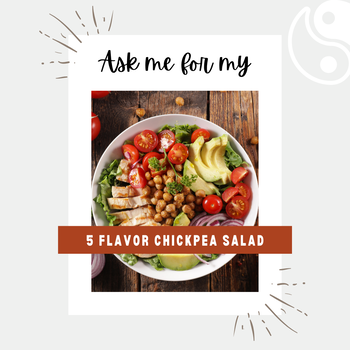 Traditional Chinese Medicine (TCM) nutrition combines ancient wisdom with modern science. TCM nutrition is a holistic approach, which aims to balance all five flavors within most meals with one or two flavors being emphasized for therapeutic purposes. TCM nutrition for hypertension emphasizes bitter flavors, sour flavors, and energetically-cooling foods. TCM theory states the bitter flavor benefits the heart in moderation but an excess is harmful as it has a drying effect; for example, coffee is bitter. In moderation, coffee acts as a vasodilator increasing circulation but in excess, it can raise blood pressure and has a diuretic effect. Modern scientific research has discovered while the human genome has 25 bitter taste receptors 12 of these are expressed in the human heart. Foods with bitter flavors include romaine lettuce, dandelion, arugula, rye. Foods that combine bitter with pungency include citrus peel, radish, scallion, and white pepper. In TCM nutrition the pungent flavor can help disperse phlegm (e.g. plaque). Foods that combine bitter with sweet include asparagus, celery, tomatoes, lettuce, quinoa, and papaya. Lemon rind is bitter and sour; vinegar is also bitter and sour. Bitter flavors have a yin, or cooling effect, clearing heat in the body while encouraging a descent of Qi, which aids in the draining of fluids. For example, celery contains the phytochemical phthalides which relax arterial wall tissues to increase blood flow and thereby reduce blood pressure. The fiber, magnesium, and potassium in celery also help lower blood pressure and regulate fluid balance. Caution: according to TCM, those with a lot of dryness and/or bone disease should moderate their intake of bitter flavor. A tomato a day keeps the doctor away! The combination of lycopene, vitamin C and E, potassium, and folic acid in tomatoes make it a powerful food for heart health. The bitter flavor of tomatoes comes from the seeds; to reap the full benefit of tomatoes eat the seeds too. Heirloom tomatoes in the season have the most flavor, find the tastiest tomatoes at your farmer’s market or try growing your own. Chrysanthemum tea is very popular in Asia; it is helpful for headaches, dizziness, high blood pressure, chest pain, and also fevers. You can add chrysanthemum flowers to your morning green tea and in the evening combine it with chamomile tea for extra cooling benefits! TCM nutrition cautions against overdoing cold foods and drinks. Too much cold inhibits the digestive process. Drinking warm beverages and soups, as well as eating foods with a little pungency (chili pepper, garlic, ginger) causes the body to perspire slightly which naturally cools the body. 5 Flavors Chickpea Salad for Healthy & Happy Heart 15 oz cooked organic chickpeas (1 can) 1/2 c cup cooked quinoa or 1 cup brown rice (warm) 4 stalks celery, minced 6-12 cherry tomatoes, chopped in 1/2 or 1/4 8-12 Romaine lettuce leaves, chopped 2 TBSP red onion, minced Toss with a dressing made with: 2 TBSP olive oil 1 TBSP lemon juice + a little lemon zest (organic is best) 1 tsp grated ginger 1/2 tsp honey or agave 1-2 garlic cloves (minced or pressed) 1/8 tsp Himalayan or Sea salt (or to taste) fresh ground black pepper (to taste) Interested in more? Don't hesitate to contact me or book a consultation anytime, its my pleasure to be of service! ~Yours in Heart Healthiness. Rebecca Resources https://health.clevelandclinic.org/2015/04/celery-may-help-bring-your-high-blood-pressure-down/ Foster, S. R., Blank, K., Hoe, L. E. S., Behrens, M., Meyerhof, W., Peart, J. N., & Thomas, W. G. (2014). Bitter taste receptor agonists elicit G-protein-dependent negative inotropy in the murine heart. The FASEB Journal, 28(10), 4497-4508. Kastner, Joseph, MD, L.Ac, (2009) Chinese Nutrition Therapy, Thieme, Stuttgart and New York Pitchford, Paul (2002), Healing with Whole Foods: Asian Traditions and Modern Nutrition, North Atlantic Books, Berkeley, California Ried, K., Frank, O. R., Stocks, N. P., Fakler, P., & Sullivan, T. (2008). Effect of garlic on blood pressure: a systematic review and meta-analysis. BMC cardiovascular disorders, 8(1), 1. Willcox, J. K., Catignani, G. L., & Lazarus, S. (2003). Tomatoes and Cardiovascular Health. Critical Reviews in Food Science and Nutrition, 43(1), 1-18. 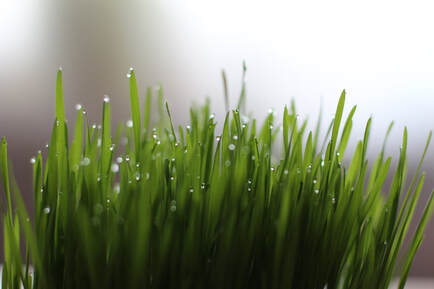 Image via Pixabay.com Image via Pixabay.com There's never been a time where health and wellness has been such an integral part of global conversations. People are now more interested in what they're eating and putting into their bodies. Food isn't just about eating, it's about creating a healthier, better life for yourself and your families. We've previously written about '5 Immunity Boosting Recipes' that can help keep you and your loved ones safe during flu season and beyond. Today, we're going to be talking about an easy, accessible supplement that can give you the important nutrients and vitamins that you need to make your life better and brighter. What is Wheatgrass? Wheatgrass is one of the many superfoods that have taken the world by storm over the past few years. It's the young grass of the common wheat plant Triticum aestivum, and unlike other superfoods that are grown in tropical climates can be grown in nearly every climate. Wheatgrass is typically harvested at 5 to 8 inches tall. Cut too early and it's too sweet and lacks the essential nutrients, too late and it's too bitter. Wheatgrass Benefits Like many superfoods, wheatgrass is filled to the brim with a host of different vitamins and nutrients. Wheatgrass contains several amino acids, which SF Gate reports are able to perform several functions in the body. These functions include protein synthesis, enzyme synthesis, and the growth and maintenance of cells. Out of 3,500 milligrams of wheatgrass, there are a whopping 700 milligrams of amino acids. Healthline has put together an exhaustive list of research on wheatgrass's many benefits. According to researchers, wheatgrass may reduce cholesterol, as well as reducing the risk of heart disease. It can also aid in regulating blood sugar levels and has anti-inflammatory properties, making it a great supplement for protecting the body against infections and injuries. Some also posit that wheatgrass can even help kill cancer cells in test tube studies, although further research is needed on anti-cancer effects in humans. How to Get Wheatgrass Because wheatgrass is so easy to grow, it's easy to set up your own crop at home. Once it's grown to the appropriate height, you can cut it a few inches above the root, wash, and then dry them. You can then air dry or oven-dry it and then process it into powder, which can then be added to supplement your food or mix into drinks. For convenience, you can also purchase wheatgrass capsules or powder. Both options are easy, convenient, and use a cold-drying process that Brightcore states preserves the healthy enzymes and vitamins found in the plant. They're also fairly safer — wheatgrass is typically consumed raw in order to make the most of the health benefits, but in some cases might contain harmful mold or bacteria. Because wheatgrass is consumed raw, it's always best to check in with your doctor or nutritionist before taking it as a supplement. It's not always recommended for pregnant women or people with immune deficiencies, and people with gluten sensitivities should also be cautious. On the whole, however, it's an easy, convenient, and all around great choice for boosting your health.  Everywhere you go these days, you see people carrying bottled water. And because of the emphasis that has been placed on drinking water, it is now the second most popular drink in the United States. This is really important because every cell in our bodies depends upon water to function. And with every hour that passes, our bodies lose water. Unless we replace that, we literally can shrivel up and die. Water intake is important for so many reasons. Water helps maintain the balance of bodily fluids. Every time we breathe, eat, urinate, defecate or sweat, we are using water in some way. There are also ways that we use water that we don’t see, like the circulation of our blood and lymphatic fluids, the transportation of nutrients in our bodies and the regulation of our body temperature. For all these processes to occur, water is needed. This is the number one reason that drinking water is so important. Drinking water also helps us control our caloric intake. For many people, weight loss is a big deal and not necessarily an easy battle. But drinking water with every meal instead of some other beverage that is full of calories is always the best option. Not only do you avoid ingesting unwanted calories that can possibly turn into unwanted pounds, but you can also feel fuller faster. This makes it less likely that you will eat as much and this can help keep the waistline slim. As mentioned before, every cell in our bodies needs water to function and the muscles are no different. In fact, drinking water actually helps to energize the muscles. Muscle fatigue is frequently caused by a lack of water in the cells themselves. And while we’re discussing the muscles, the elephant in the room needs to be addressed. Many people believe that drinking water after a massage helps flush toxins out of the muscles. This is actually not true and science has proven it. In fact, the process of massaging the muscles actually creates a slightly toxic effect within the muscles known as rhabdomyolysis. And no amount of water will change that because rhabdomyolysis is an unavoidable side effect of massage that occurs just like after an intense workout. Another reason to drink water is an obvious one. Water helps to keep your body regular. This includes urination and defecation. But on an even deeper level, when we are properly hydrated, our kidneys and intestines can function properly and help remove waste products from the body. A buildup of waste products can lead to illness and death. Lastly, staying hydrated keeps your skin looking healthy and vibrant. Dehydration makes the skin look dry and wrinkled. But this doesn’t mean that overhydrating will reverse those wrinkles completely. Getting enough water can definitely help, but once the body is fully hydrated, the kidneys will get rid of the excess fluid. Any of these are great reasons to drink water, but do you really need a reason? When people are properly hydrated, they look and feel better. So pick up that glass of water and take a big gulp. Your body will appreciate the attention and continue to support you in return. 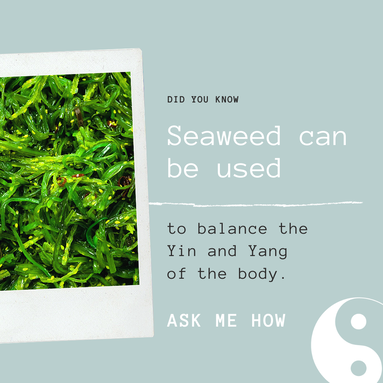 Seaweed has been consumed as a health aid and food enhancer for years in Asia, but recently there has been a growing interest in seaweed as a health superfood and for sustainable farming. Seaweed, otherwise known as Hai Zao in Chinese medicine, is known as a marine algae, or sea vegetable that grows primarily in salty waters. Three main classifications of seaweed are brown, red and green. Brown seaweed includes kombu, which is eaten widely in Japan, the red variety includes nori (which is seen in sushi wraps) and dulse. Green is the most common, and is known as wakame. In Chinese medicine, seaweed is used to balance the yin and yang of the body. Your yin encourages fluid, lubrication, moistening, cooling and stillness. Yang is associated with more heat, dryness, warming and movement. As one gets older, it is common to get yin deficiency. When you have yin deficiency, heat rises due to yin depletion not balancing the yang energy. Many menopausal women experience this yin deficiency in the form of hot flashes, low back pain, night sweats, poor memory, fatigue, ear ringing, dry skin and loss of vaginal lubrication. One food that has been shown to help is seaweed. Seaweed is in the category of “cold and salty” of food quality and temperature in Chinese medicine. It is said to nourish the yin and is eaten along with other foods like yams and black sesame seeds that help balance yin and yang. In addition to helping yin deficiency, seaweed “softens hardness” and loosens phlegm. What this means is seaweed helps dissipate nodules and soft swellings, as in lipomas, cysts, lumps and fat accumulation. Clinically, seaweed is used for swelling of the thyroid gland seen in goiter. See your acupuncture provider to get a diagnosis, formula and diet specific to your body’s needs. Seaweed has been shown to have loads of essential vitamins and minerals such as vitamin C, vitamin K, magnesium, calcium, iron, B vitamins, potassium and folic acid. Most importantly, seaweed has a lot of iodine. Iodine helps the thyroid for growth, metabolism and the immune function. When your thyroid is functioning at a low level, you may experience fatigue, muscle weakness, palpitations, sensitivity to sun, weight gain and goiter. Iodine used to be abundant in rich soil but has been depleted nowadays. Promising research indicates seaweed helping edema, fibroid tumors, limiting cancer growth due to phytochemicals called lignans and boosting immunity. In addition, it has been used as an anti-inflammatory aid for arthritis, to lower blood pressure and high cholesterol and to aid the respiratory system. Seaweed in Asia has been traditionally used for menopausal signs and symptoms, to reduce swollen lymph glands and to boost libido. But in general it is great for the skin, hair, teeth and bones. Seaweed is very alkaline and helps the pH balance of the body. Despite the benefits, there is a strong contraindication if you are hyperthyroid. In addition, moderation is key in all aspects. Too much iodine can raise the thyroid-stimulating hormones, and individuals who are sensitive can get heart palpitations, nervousness, irritability and sweating. Check with your doctor to be sure an increase in iodine is right for you. Eat small portions about once a week. You can buy seaweed dry, powdered or in supplements. Be mindful where it comes from and buy organic to reduce metals, arsenic and toxicity found in waters around the world. An added benefit for seaweed is sustainability. Kelp is considered the perfect crop, as it requires little care and feeding to grow abundantly. With all the health benefits and easy farming, it just might be the superfood of the future. |
AuthorsRebecca M H Kitzerow is a Licensed Acupuncturist practicing in La Center, Washington. With over a decade of experience she has won 10 Nattie consumer choice awards from Natural Awakenings Magazine since 2014. Archives
July 2024
Categories
All
|
Photos from Hey Paul Studios, BeGreen_Studio, Pawel Pacholec, 1950sUnlimited, toulupaliaqaz, Joelk75, OnTask, Robert Gourley, cnu_sports, Mitya Ku, wuestenigel (CC BY 2.0), FootMassagez, 401(K) 2013, Mariana Heinz, @EdwardTerry, fishhawk, liverpoolhls, torbakhopper, Boemski, dolomitibl, Driscolltheque, Dave n Laura, Vaping360, MVWorks, Life Mental Health, MVWorks, mikefats, Scot Nelson, jfl1066, wZa HK, ruurmo, Guadalupe Cervilla, Army Medicine, GViciano, torbakhopper, adrigu, Saulo Cruz, Ben Cumming, marniejoyce, kcxd, JasonCorey, kanenas.net, Live to Create Photography, gm.esthermax, Unique Hotels Group, Zenspa1, mysiana, Tobias Lindman, Leader Nancy Pelosi, Kristoffer Trolle, swanksalot, Bill Selak, Parker Knight, stimpsonjake, Gedankensprudler, SuperFantastic, tonynetone, marniejoyce, JeepersMedia, Illusive Photography, 'Ajnagraphy', Iban Torras, scotted400, gtall1, dvanzuijlekom, BPPrice, Skley, torbakhopper, Renato Ganoza, anka.albrecht, QUOI Media, Public Domain Photos, Instant Vantage, Victor Tongdee, Free Grunge Textures - www.freestock.ca, sportEX journals, Nadja Tatar, angela n., marniejoyce, MVWorks, Karolina Kabat, Thomas Fisher Rare Book Library, UofT, ginnerobot, tracilawson, haven't the slightest, My Photo Journeys, Pierre Willemin, Florena_Presse, SuperFantastic, colindunn, zzkt, TraumaAndDissociation, ER24 EMS (Pty) Ltd., shixart1985 (CC BY 2.0), marniejoyce, Tomás Fano, freestock.ca ♡ dare to share beauty, Archives New Zealand, Jaykhuang, airdrie.m, Go-tea 郭天, OnTask, wuestenigel, focusonmore.com, Disney | ABC Television Group, Andrew Gustar, Didriks, ConstructionDealMkting, charlywkarl, barnimages.com, Lel4nd, runwaypilates, michaelstephanfotografie, McLevn, TraumaAndDissociation, eLife - the journal, Lars Plougmann, wuestenigel, shixart1985, boviate, davis.steve32, kevin dooley, @the.photoguy (insta), frederic.gombert, Feathering the Nest, Victor Tondee, shixart1985, wuestenigel, Joe K Gage, kennethkonica
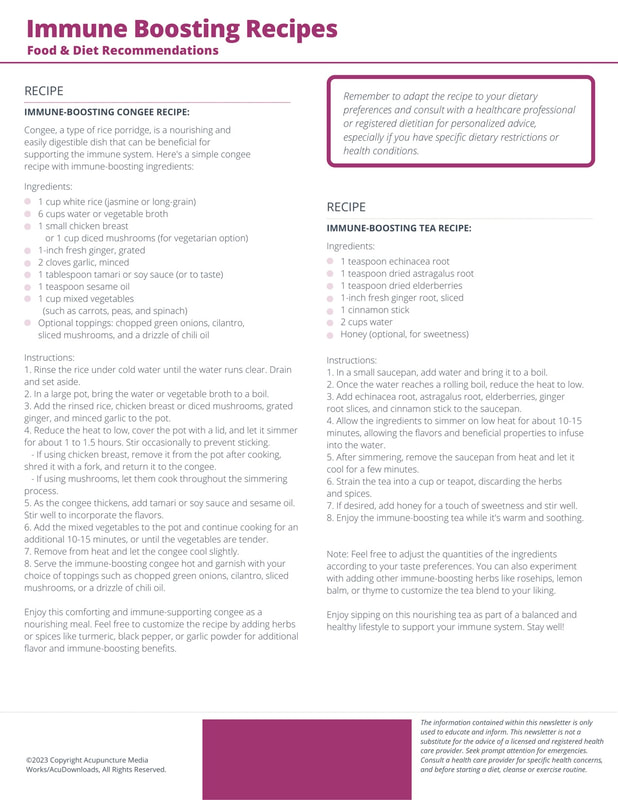

 RSS Feed
RSS Feed
